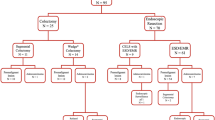Abstract
Purpose
Endoscopically unresectable apparently benign colorectal polyps are considered by some surgeons as ideal for their early laparoscopic colectomy experience. Our hypotheses were: (1) a substantial fraction of patients undergoing laparoscopic colectomy for apparently benign colorectal neoplasia will have adenocarcinoma on final pathology; and (2) in our practice, we perform an adequate laparoscopic oncological resection for apparently benign polyps as evidenced by margin status and nodal retrieval.
Methods
Data from a consecutive series of patients undergoing laparoscopic colectomy (on an intention-to-treat basis) for endoscopically unresectable neoplasms with benign preoperative histology were retrieved from a prospective database and supplemented by chart review.
Results
The study population consisted of 63 patients (mean age 67, mean body mass index 29). Two out of 63 cases (3%) were converted to laparotomy because of extensive adhesions (n = 1) and equipment failure (n = 1). Colectomy type: right/transverse (n = 49, 78%); left/anterior resection (n = 10, 16%); subtotal (n = 4, 6%). Invasive adenocarcinoma was found on histological analysis of the colectomy specimen in 14 out of 63 cases (22%), standard error of the proportion 0.052. Staging of the 14 cancers were I (n = 6, 43%), II (n = 3, 21%), III ( = 4, 29%), and IV (n = 1, 7%). The median nodal harvest was 12 and all resection margins were free of neoplasm.
Neither dysplasia on endoscopic biopsy nor lesion diameter was predictive of adenocarcinoma. Eight out of 23 (35%) patients with dysplasia on endoscopic biopsy had adenocarcinoma on final pathology versus 6/40 (15%) with no dysplasia (p = 0.114, Fisher’s exact test). Mean diameter of benign tumors was 3.2 cm (range 0.5–10.0cm) versus 3.9cm (range 1.5–7.5cm) for adenocarcinomas (p = 0.189, t - test).
Conclusion
A substantial fraction of endoscopically unresectable colorectal neoplasms with benign histology on initial biopsy will harbor invasive adenocarcinoma, some of advanced stage. This finding supports the practice of performing oncological resection for all patients with endoscopically unresectable neoplasms of the colorectum. The inexperienced laparoscopic colectomist should approach these cases with caution.
Similar content being viewed by others
References
COST Study Group (2004) A comparison of laparoscopically assisted and open colectomy for colon cancer. N Engl J Med 350:2050–9
Ross HM, Li C, Rosenthal J, Kessler J, Fogt F (2006) Laparoscopic colon resection for polyps: a good novice case? Dis Colon Rectum 49:879–82
Lo SH, Law WL (2005) Laparoscopic colorectal resection for polyps not suitable for colonoscopic removal. Surg Endosc 19:1252–5
Pokala N, Delaney CP, Kiran RP, Brady K, Senagore AJ (2007) Outcome of laparoscopic colectomy for polyps not suitable for endoscopic resection. Surg Endosc 21:400–3
Joo JS, Amarnath L, Wexner SD (1998) Is laparoscopic resection of colorectal polyps beneficial? Surg Endosc 12:1341–4
Eijsbouts QA, Heuff G, Sietses C, Meijer S, Cuesta MA (1999) Laparoscopic surgery in the treatment of colonic polyps. Br J Surg 86:505–8
Nusko G, Mansmann U, Altendorf-Hofmann A, Groitl H, Wittekind C, Hahn EG (1997) Risk of invasive carcinoma in colorectal adenomas assessed by size and site. Int J Colorectal Dis 12:267–71
Shinya H, Wolff WI (1979) Morphology, anatomic distribution and cancer potential of colonic polyps. Ann Surg 190:679–83
McDonald JM, Moonka R, Bell RH Jr. (1999) Pathologic risk factors of occult malignancy in endoscopically unresectable colonic adenomas. Am J Surg 177:384–7
Zuro LM, McCulloch CS, Saclarides TJ (1992) Laparoscopic colotomy, polypectomy. Innovative minimally invasive procedure. AORN J 56:1068–73
Author information
Authors and Affiliations
Corresponding author
Additional information
Presented at the Society of Gastrointestinal Endoscopic Surgeons Annual Meeting, Las Vegas, NV, April 21, 2007
Rights and permissions
About this article
Cite this article
Brozovich, M., Read, T.E., Salgado, J. et al. Laparoscopic colectomy for apparently benign colorectal neoplasia: A word of caution. Surg Endosc 22, 506–509 (2008). https://doi.org/10.1007/s00464-007-9497-0
Received:
Accepted:
Published:
Issue Date:
DOI: https://doi.org/10.1007/s00464-007-9497-0




